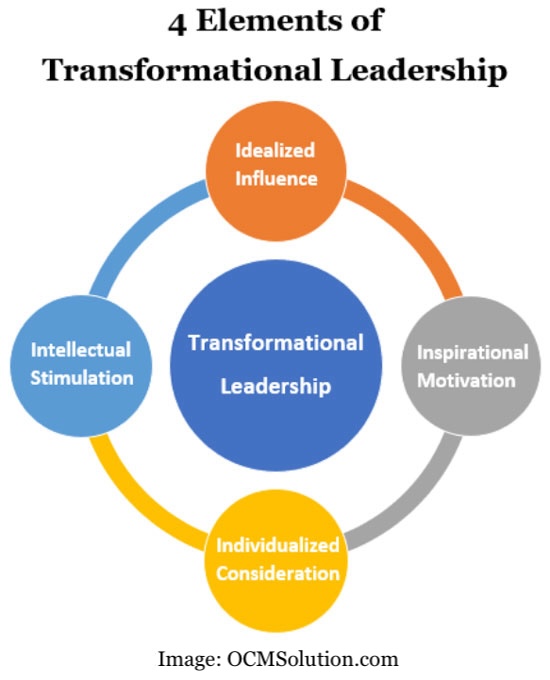Best Guide to Everything You Need to Know about Transformational Leadership in Schools

Welcome to the World of Transformational Leadership in Education!
Hey there, educators, administrators, and all the fantastic folks shaping the minds of tomorrow! If you’ve ever wondered what makes an outstanding school leader tick, or if you’re keen on elevating your own leadership game, you’re in for a treat.
We’re about to embark on a journey into the realm of Transformational Leadership – the secret sauce that transforms schools from ordinary to extraordinary.
Picture this: a school where leaders inspire, innovate, and instigate positive change, creating an environment where everyone thrives. That’s the magic of transformational leadership in education, and we’re here to spill the beans on what it’s all about.
In this friendly guide, we’ll break down the nuts and bolts of transformational leadership, exploring why it matters, how it works its wonders, and why it’s a game-changer for schools of all shapes and sizes. Whether you’re a seasoned educator looking to revitalize your leadership style or a curious newcomer eager to understand the buzz, we’ve got you covered.
So, buckle up and let’s dive into the fascinating world of transformational leadership in education – where inspiration meets innovation, and every school day holds the potential for positive change!
Excited to explore the journey ahead? We’ve crafted a brief summary just for you. Get ready to dive into the intricacies of transformational leadership in education & schools, with the assurance that we’re here to accompany you on this enlightening adventure.
Quick Summary
Leading the Way: Unpacking the Importance of Educational Leadership
Educational leadership is crucial for structuring schools, fostering continuous improvement, and realizing the mission of providing quality education. School leadership involves creating a strategic vision, ensuring equal opportunities for students, training teachers in leadership, enhancing curriculum and educational experiences, addressing underperforming areas, delegating responsibilities for improved leadership, and advocating for change. Kenneth Leithwood emphasizes the vital role of powerful leaders in turning around troubled schools. Transformational leadership is highlighted as more effective in transforming schools compared to authoritarian styles.
Shared Visions: Exploring the Dynamics of Distributed Leadership in Education
Distributed leadership in education involves leaders collaborating to share overall leadership duties, with equal input and importance from everyone. It creates a collaborative “brain trust” to identify and implement changes, fostering effective school leadership as a team effort supporting the school’s mission. Benefits include a collective team spirit and a balanced mix of leadership styles. However, challenges may arise from personality conflicts among leaders and rigid organizational structures that hinder the effective implementation of distributed leadership in education.

Beyond the Podium: A Journey Through Varied Educational Leadership Styles
Different leadership styles in education impact how leaders interact with students and teachers. The following are various leadership styles in education:
- Transformational Leadership in Education:
- Focuses on personal connections, inspiration, and a passion for improvement.
- Emphasizes continuous improvement to create the best educational environment.
- Potential drawback includes a tendency to overlook detailed aspects.
- Instructional Leadership in Education:
- Principally involves the management of curriculum and instructional methods.
- Can be either “exclusive” (principal-centric) or “inclusive” (distributed leadership).
- Some see it as limited, advocating for a broader focus on continual improvement.
- Transactional Leadership in Education:
- Common in classrooms, it relies on rewards and punishments.
- Effective in primary grades but less so with older students or adults.
- May lead to feelings of undervaluation and resentment.
- Participative Leadership in Education:
- Team-oriented, emphasizes collaboration among students, teachers, parents, and administrators.
- Values democratic processes and collective problem-solving.
- Potential drawbacks include longer decision-making processes and conflicts within the group.
- Cultural Leadership in Education:
- Recognizes the influence of the school’s culture on its educational mission.
- Values the impact of culture on student success and staff-student belonging.
- May hinder innovation and inclusivity, as it adheres to traditional ways and may exclude those who don’t fit the cultural mold.
The leadership styles are influenced by administrators’ and teachers’ personalities but can be deliberately adopted for desirable outcomes in education. Each style has its benefits and potential drawbacks, impacting the overall effectiveness of school leadership.
Elevating Excellence: The Rewards of Transformational Leadership
Transformational leadership in education, characterized by qualities such as excellent communication, innovation, vision, and a team-oriented spirit, offers various benefits to educational institutions:
- Reduces Staff Turnover:
- Transformational leaders foster a sense of value and shared purpose, reducing staff turnover.
- Coaching and mentoring build stronger teams, leading to increased job satisfaction.
- Drives Innovation in Education:
- Transformational leaders actively seek new and better educational methods through continuous curiosity and a commitment to improvement.
- They promote a culture of innovation, staying informed about the latest studies and driving positive change.
- Creates New Leaders:
- Transformational leaders act as “leader factories,” coaching and mentoring individuals to develop exceptional leadership skills.
- They contribute to building a pool of capable leaders with traits such as innovation and collaboration.
- Motivates Others to Give Their Best:
- Unlike fear-based motivation, transformational leadership inspires individuals to give their best by fostering a sense of inspiration and teamwork.
- Motivation stems from a shared commitment to the school’s improvement and mission.
- Creates More Positivity:
- Transformational leaders reduce personality conflicts by making each team member feel valued.
- Their leadership style generates a positive atmosphere of mutual respect and purpose within the educational institution.
Transformational leadership stands out among educational leadership styles, emphasizing positivity, collaboration, and continuous improvement for both individuals and the organization as a whole.

Behind the Magic: The Mechanics of Transformational Leadership
Transformational leadership in education emphasizes learning from various leadership styles and incorporating effective qualities. The approach involves self-awareness, recognizing strengths and weaknesses, and actively working to improve leadership styles. Transformational leaders view challenges as opportunities for improvement and welcome educational leadership challenges.
To inject transformational leadership in educational institutions, leaders can:
- Motivate Through Shared Goals:
- Use shared goals as motivators rather than relying on punishment/reward systems.
- Build Leadership:
- Foster leadership development in education by actively working to build leaders within the institution.
- Evolve Leadership Foundations:
- Explore new ways to evolve the foundation for leadership in education continually.
- Strive for Improvement:
- Maintain a continuous focus on improvement and expect the same commitment from those being led.
- Incorporate Positive Traits:
- Study other effective leadership styles in schools to incorporate positive traits into one’s own leadership style.
- Simplify Vision Statements:
- Practice simplifying mission or goal statements into clear vision statements.
- Encourage Collaboration:
- Invite collaboration from different leadership styles in education.
- Check Ego and Lift Others:
- Check ego at the door, be willing to lift others up, and mentor those with potential for effective school leadership.
- Champion Change:
- Actively champion change to improve institutional objectives.
The Four I’s of Transformational Leadership, as proposed by Bernard Bass, help identify effective leadership qualities:
- Inspirational Motivation:
- Transformational leaders motivate through setting a good example and providing a sense of purpose and shared vision.
- Individualized Consideration:
- Transformational leaders take time to know each individual, value their opinions, and personally coach them to reach their potential.
- Intellectual Stimulation:
- Leaders encourage creative thinking and go beyond conventional concepts, particularly emphasizing problem-solving skills.
- Idealized Influence:
- Transformational leaders have a positive influence, gaining respect and admiration, which encourages others to willingly follow their direction.
Detailed Deep Dive
In this top OCM Solution article on transformational leadership in education, we are going to review the importance of leaders and leadership in education and the types of leadership styles in education. We’ll also explain how transformational leadership is essential for schools in several ways.
Which school leadership styles promote the best school leadership qualities? What are the most important characteristics of educational leadership?
We’ll explain how the types of school leadership styles you use have a significant impact on the success of educational objectives and go through transformational leadership examples in education.
By the end of this article, you should have a good idea of the different school leadership models and styles, and a good grasp of the benefits of transformational leadership in higher education and elementary education.
See Also: The Best Guide for Change Management in Education Institutions
Do you have questions on a transformational leadership framework or transformative educational leadership? We’d love to hear from you, click here to contact us.
School Leadership and The Educational Leader’s Role
School leadership can be defined as the act of guiding teachers, students, parents, and administrators to promote and achieve academic success. Effective school leadership has multiple tiers, which include both administrators and teachers.
The educational leader role for a principal or vice-principal will look a little different than the educational leadership definition for a teacher. Still, both are equally important to the educational institution and its mission.
Administrators may be looking at the entire school leadership framework to keep teachers, staff, and students productive and satisfied. They’ll also interface with policymakers at the district level. Their job is to ensure effective school leadership practices are in place throughout the entire organization.

What is Transformational Leadership in Education?
Teachers, on the other hand, look at leadership in school setting environments as how they lead and guide their students and interface with parents. Some teachers may also exhibit qualities of an effective school leader and mentor other teachers who may be new to the profession.
Educational leadership qualities are important because they can separate the “good” leaders from those that may have shortcomings. There are also different school leadership styles that can impact how effective a leader is in a given situation.
The Importance of Educational Leadership
The educational leadership meaning for schools is as a driving force for structure, continuous improvements, and enabling the mission of providing quality education.
The school leadership definition includes the ability to:
- Create a strategic vision for others to follow
- Ensure all students have equal opportunity for academic success
- Nurture and train teachers on leadership skills in schools
- Work to continually improve curriculum and the educational experience
- Improve areas in schools that are underperforming
- Delegate duties with a goal of improving school leadership
- Promote and champion change
To help define educational leadership importance in schools, we found this quote from Kenneth Leithwood, professor at the University of Toronto. Mr. Leithwood stated, “Indeed, there are virtually no documented instances of troubled schools being turned around without intervention by a powerful leader.”
Leadership development in education over the years has found that transformational leaders can often better transform schools to serve students and teachers, than can those using more authoritarian types of school leadership styles.
Don’t Miss: Change Management Training | All You Need to Know | Employees & Leaders
Got questions like “What is transformational leadership education?” or “What is the best transformational leadership style in education?”. Drop us a message and let us know.
Leadership in Higher Education vs Primary
Educational leadership challenges at their core are similar in all levels of education. Both leadership in elementary and high school grades and leadership in educational institutions of higher learning, all strive to operate efficiently and provide the best education possible for students.
The foundation for leadership in education has administrators performing similar functions, whether they’re at a college or elementary school. Where the effective leadership styles in schools may differ more, is with the teachers.
Because the students are quite different between primary and higher education institutions, some effective leadership styles in education at a university, such as those that are more democratic, may not work as well at lower grades.
For teachers evaluating effective leadership qualities in education and wondering which styles are best for their classroom, considering the student level is important. Younger students may require more structure than older students, which can change the leadership styles in education that one is considering adopting.
What is Distributed Leadership in Education?
What is educational leadership when it comes to distributed leadership in education?
Leadership in higher education and primary grades may use what’s known as distributed leadership in education. This is when leaders band together to share overall leadership duties, everyone is seen as having equal input and importance.
Distributed leadership in education is used to create a “brain trust” where a team can work together to identify areas of improvement in a school and share responsibilities leading and implementing change.
Effective school leadership using distributed leadership is seen as a team effort where everyone is pitching in to help and do what’s needed to support the mission of the school.
Benefits of Distributed Leadership in Education
The advantage of using distributed leadership in education is that schools can have a collective team spirit that comes from leaders working together towards a common goal. The mix of each different educational leader role can also provide a nice balance of different styles.
Drawbacks of Distributed Leadership in Education
Educational leadership challenges with using this model can include personality conflicts between the different leaders that can get in the way of positive forward motion. Rigid organizational structures can also make it difficult to use distributed leadership in education.
Related: Prosci ADKAR Change Management Model – Still Relevant?
Are you looking for answers to questions like “As a future teacher how can you be a transformative leader?” or “What is transformative leadership in education?”. Send us a message with your questions or comments.
What are Different Leadership Styles in Education?
Educational leadership qualities can often differ according to the personal school leadership styles of the administrators and teachers.
For example, a teacher using transformational leadership in education will have a completely different relationship with students than one using transactional leadership in education.
So, are the different types of educational leadership only based upon the personality of the leader? Yes and no.
While a leader’s personality may mean they naturally gravitate to certain leadership models in education over others, that doesn’t mean that they can’t purposely adopt desirable school leadership qualities from a particular leadership style.
In fact, the purpose of studying educational leadership definition of the different styles is to see which provide the best outcomes in educational quality and organizational improvement.
The importance of educational leadership can often be seen in the most effective leadership styles in schools.
Types of Educational Leadership
The following are some of the main leadership styles seen when studying effective school leadership practices.
Transformational Leadership in Education
Many of the best characteristics of educational leadership are said to come from using transformational leadership in education.
The transformational leader takes a personal interest in each individual that they lead and is seen as an inspirational leader. They are very vision and goal-oriented and show a passion for what they do.
Those they lead are often motivated to follow directions because they feel valued and nurtured. This type of leader also tends to be charismatic and well-liked.
Transformational leadership in schools is seen as vital because this style of leader is continually looking for ways to improve an institution’s processes and methods to further the mission of giving students the best educational environment possible.
One area where transformational leadership in education may be seen as lacking is that they tend to be a “big picture” leader and can sometimes miss some of the detail needed to reach the end goal.
Instructional Leadership in Education
One of the narrower styles when looking at educational leadership meaning is instructional leadership in education. This is a style that is focused mainly on the principal as the main driver for leadership through the management of curriculum and instruction methods.
Instructional leadership in education puts the emphasis on learning, how that is measured, and which methods produce the best results.
There are two thought processes when it comes to instructional leadership in education; one is “exclusive,” which focuses on the principal as the main leader that is setting learning objectives and delegating tasks to make that happen.
The other model is “inclusive,” which is more of a distributed leadership style, focused on bringing in teachers and other school leaders with the principal leading the group.
Some feel that this is a very limited style when looking at school leadership definition. That curriculum, while important, should be part of the larger ongoing efforts for continual improvement.
Transactional Leadership in Education
The most common style seen in the classroom setting is transactional leadership in education. This is a reward/punishment leadership style, which may not work well between administrators and teachers, but is often necessary between teachers and students.
Followers of those using transactional leadership in education are told what to do, and they follow orders. They’re rewarded with good grades and sometimes special treats when they do well. When students act up, they can be sent to the principal’s office or detention.
Transactional leadership in education is not about motivating change or continuous improvement; it’s about order, structure, and having students follow directions.
This is one of the school leadership models that is necessary, especially in primary and lower grades. But the older the followers of the leader get, the less effective it is.
For example, this is not one of the types of leadership styles in education that you’d want to use with a teacher if you were the principal. When used with adults, this style can lead to feelings of not being valued and resentment.
When used to lead adults, the transactional leadership style in education can also lead to high staff turnover rates because people don’t feel their input is being considered, and they don’t feel nurtured or that they matter.
Participative Leadership in Education
Those who use participative leadership in education are very team-oriented and believe in building a coalition of students, teachers, parents, and administrators to enrich the educational experience as well as tackle any issues that may arise.
Their leadership skills in school include excellent communication skills. They believe in “keeping everyone in the loop” and inviting feedback. They believe in improving school leadership by using a more democratic process.
Participative leadership in education can often spark great ideas because the collective power of the group is brought in on any challenges. This type of leader will often define the school leadership framework as a team rather than an individual.
Where participative leadership in education can fall short is that it makes for a much longer-decision making process, and sometimes some decisions need to be made without group input.
Those using participative leadership in educational institutions can also run into trouble if those in the group have conflicting opinions or personality types.
Cultural Leadership in Education
Cultural leadership in education recognizes the importance of the educational institution’s culture in driving forward the educational mission of the school. For example, a school like MIT has a specific culture that is different from a school like Carnegie Mellon.
How you define educational leadership when using the cultural style is very much entwined with the personality of the school, its way of doing things, mission, and educational emphasis.

What is Educational Leadership?
Cultural leadership in education reflects the fabric of the institution, and it values the impact culture has on student success and a feeling of belonging among staff and students.
This style uses a strong vision that motivates both teachers and students, creating a sense of loyalty.
Where cultural leadership in education can hold a school back, is the fact that it can become a barrier to innovation and change for fear of letting go of “how it’s always been done.”
Those depending upon cultural leadership in education to motivate students can also find that not everyone feels included, and the style can leave some people out that don’t fit into the mold of the culture.
What are the Best Leadership Models in Education?
There is no “one size fits all” approach when it comes to leadership development in education.
While transformational leadership in higher education may be the best fit for a teacher/student relationship, in primary grades, you need to include plenty of transactional leadership in education to keep classes on task.
But when we’re discussing qualities of an effective school leader for administrators, then transactional is going to cause problems with staff feeling undervalued.
When it comes to the school principal or head administrative leaders, transformational leadership examples in education provide a more supportive environment where staff feels valued.
People also often answer, “What is transformational leadership in education,” with “the best style to drive positive and continuous change.”
Leadership in school setting environments is often dealing with many different personality types, and transformational leaders tend to have the ability to motive everyone through a shared vision and purpose.
How is Transformational Leadership Important for the School?
Leadership in educational institutions, perhaps more so than in any other field, need to push those they lead to think beyond the norms to expand their way of thinking and develop problem-solving skills.
Always challenging those they lead to do more and permitting them to try new things are hallmarks of transformational leadership in education. This is also how institutions can remain inventive and prevent stagnation.
Leaders and leadership in education benefit from a common purpose and shared vision, and this is a foundation for leadership in education using the transformational style.
When you explain how transformational leadership is important for the schools, it’s nearly synonymous with explaining why change is important for the schools.
Often, without transformational leaders in education, schools can find themselves remaining static and quickly becoming irrelevant in an ever-advancing world of new technology, new teaching models, and new concepts of what education means.
Popular Article: Change Management Consultant | All You Need to Know | Pay Rates, Getting In & More
Are you looking for more information on questions like: “What are the characteristics of transformational leadership in education?” or “What is transformational leadership theory in education”?. Send a message to our change management team.
What are the Benefits of Transformational Leadership?
Of all the effective leadership styles in education, transformational leadership in schools is one of the most impactful. It incorporates many effective leadership qualities in education that positively affect both individuals and entire organizations.
What is educational leadership if not nurturing and innovative? Transformational leadership in higher education and the administration of primary education can create a school culture of loyalty, mutual respect, and leading by example.
Some of the key qualities of transformational leaders for effective school leadership include:
- Excellent communicator
- Curious and continuously innovating
- Visionary and charismatic
- Is able to simplify complex concepts
- Fosters a spirit of the team
- Believes in out-of-the-box thinking
- Doesn’t ask followers to do anything they wouldn’t do
- Invites feedback and collaboration
- Inspires others by their passion
Here are several ways a transformational educational leader role benefits an educational institution.
Reduces Staff Turnover
When administrators adopt transformational educational leadership qualities, staff feel valued and like they’re working toward a shared purpose and mission.
Of all the types of educational leadership styles, transformational leadership examples in education build stronger team members by coaching and mentoring them. Team members also feel that their opinion is valued, so they’re likely to be more satisfied in their job.
Drives Innovation in Education
Not all leadership models in education are focused on continuous innovation and have the capacity to identify a need for change and drive it successfully throughout an organization.
Transformational leaders will often be the ones researching the newest studies on education and attending conferences to learn new and better methods to help make students of all kinds more successful.
This continuous curiosity of the educational leadership definition and desire for continuous improvement makes this one of the best school leadership styles for change and change management strategies in schools.
Creates New Leaders
School leadership qualities have to be taught, but not all leaders want to take the time to mentor others while leading them. The importance of educational leadership means that schools need to continually have a fresh batch of people ready to step up when a leader leaves or retires.
What is transformational leadership in education? Many would say they’re a “leader factory.” They take the time to get to know those they lead on an individual basis and coach and mentor them to build up their skills.
Transformational leaders teach effective school leadership practices to others, building exceptional leaders with similar traits of innovation, collaboration, and a team-oriented spirit.
Motivates Others to Give Their Best
When looking at educational leadership meaning for transactional vs transformational leaders, there is a big difference in the way that these styles motivate followers. When leading adults, the desirable characteristics of educational leadership will look different than when leading children.
If you use a carrot/stick approach with adults, motivation is most likely going to be fear of getting in trouble, which is not a great way to motivate them.
Transformational leadership in education means motivating others to give their best because they feel inspired and part of a team. When motivation comes from a willingness to help the school become better and to fulfill the shared mission, you’re going to have much better outcomes than fear-based motivation.
Creates More Positivity
In some schools, school leadership definition means breaking up conflict continually. Certain school leadership models, like distributed leadership in education, might invite power struggles within an organization.
If the leader doesn’t have the right leadership skills in school environments to deal with that conflict, it can be detrimental and leave a heavy negative atmosphere that educators have to deal with.
Transformational leadership examples in education tend to have fewer personality conflicts because of their ability to make each person on their team feel valued. Their way of improving school leadership also includes being able to generate a feeling of mutual respect and purpose that creates an atmosphere of positivity.
Are you looking for more information on “Which does a transformational teacher leader do best? Lead or Teach?” or “What are the major characteristics of a transformational leadership framework? or “Is there room for transformative educational leadership in schools?”. Send a message to our change management team.
How Does Transformational Leadership Work?
When you define educational leadership, it’s sometimes hard to separate a person’s personality from types of school leadership styles. After all, how do you learn to be charismatic?
But the point of learning these types of leadership styles in education and their strengths and weaknesses is to learn from them and incorporate the qualities of an effective school leader.
While you may not be able to learn “charisma,” you can learn to invite input from others and let them know you value their opinion.
Any type of leadership development in education means having some sense of self-awareness, being able to see your own strengths and weaknesses, and use a school leadership framework to improve any areas that could be better in your leadership style.
Transformational leaders welcome educational leadership challenges because they see them as an area of opportunity to do better.
If you want to incorporate more transformational leadership in school setting environments at your institution, here are some of the ways to do that.
Injecting Transformational Leadership in Educational Institutions
- Use a common shared goal as a motivator rather than punishment/reward
- Work to build leaders and leadership in education
- Explore new ways to evolve the foundation for leadership in education
- Continually strive for improvement and expect the same of those you lead
- Study other effective leadership styles in schools to incorporate positive traits
- Practice simplifying a mission or goal into a clear vision statement
- Invite collaboration of different leadership styles in education
- Check your ego at the door and be willing to lift others up
- Mentor followers that show an aptitude for effective school leadership
- Help champion change to improve institutional objectives

Four I’s of Transformational Leadership in Education
One way to explain how transformational leadership is important for the schools is to look at the Four I’s of Transformational Leadership. These are four elements created by one of the scholars that shaped what we know about transformational leadership.
Leadership scholar, Bernard Bass came up with four key elements that you can use to help identify effective leadership styles in education. These are connected to effective leadership qualities in education that transformational leaders are known to possess.
Inspirational Motivation
As mentioned earlier, the answer to “What is educational leadership?” can vary depending upon the age of those being led. Inspirational motivation is a trait of the transformational educational leader role that can be effective with any age group.
Transformational leadership in higher education or primary schools tends to motivate others by setting a good example and giving their followers a sense of purpose and shared vision to work toward.
Individualized Consideration
One of the important educational leadership qualities of a transformational leader is that they take the time to get to know each person on their team or in their classroom. They let them know their opinion is valued, and they take time to personally coach them to reach their full potential.
Intellectual Stimulation
What is educational leadership in any school would include intellectual stimulation, however those in a transformational educational leader role go beyond what’s in a book. They encourage those they lead to think beyond the box about other possibilities and concepts.
This is one of the leadership styles in education that is particularly good at teaching problem-solving skills because they challenge those they lead to think creatively.
Idealized Influence
Transformational leadership in higher education and elementary schools tends to have a positive influence on those they lead. Rather than having to beg and plead with followers, they gain respect and admiration due to the way they lead, which causes others to want to follow their direction without feeling forced to.
Conclusion: Transformational Leadership in Higher Education & Elementary Schools
The answer to, “What is transformational leadership?” is multi-layered. This is a leader that is seen as inspirational, motivational, nurturing, innovative, and one that takes the time to mentor each person they lead.
It’s easy to see how these educational leadership qualities will be a perfect fit for the roles of administrators and teachers alike.
But that doesn’t mean that there isn’t also something to learn from other leadership styles in education. Each style has certain traits that can be helpful in various school settings.
Those wanting to expand, what is educational leadership when it comes to how they lead can enrich their educational leader role by adopting some of the qualities of a transformational leader.
Leadership in higher education and elementary schools is vital, and perhaps the most important component to a healthy and well-performing institution. That makes it vital to continually improve upon the educational leader role.
Read More: Change Management Benefits & Importance | What You Need to Know
Note: Content on OCM Solution's ocmsolution.com website is protected by copyright. Should you have any questions or comments regarding this OCM Solution page, please reach out to Ogbe Airiodion (Change Management Lead) or the OCM Solution Team today. OCM Solution was previously known as Airiodion Global Services (AGS).
Images: https://stock.adobe.com, Microsoft 365 Clip Art Image(s) (Bing images licensed under the Creative Commons license system.)






